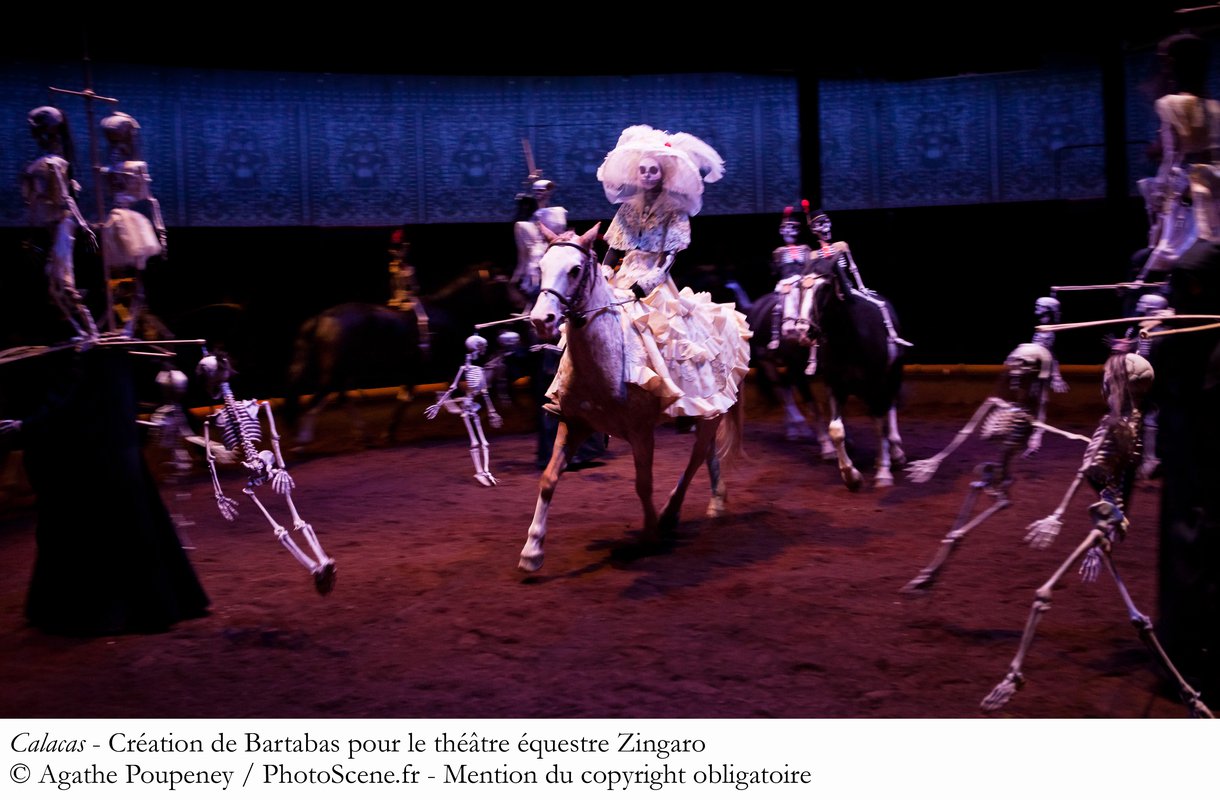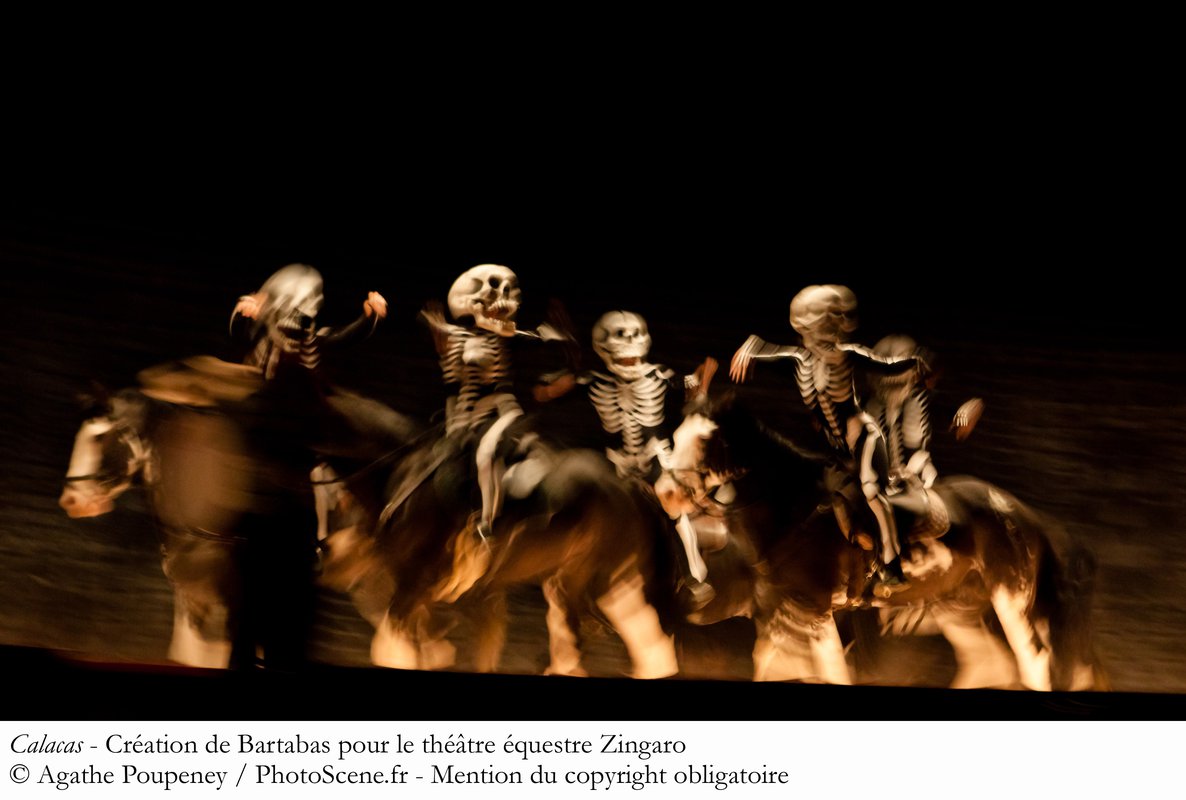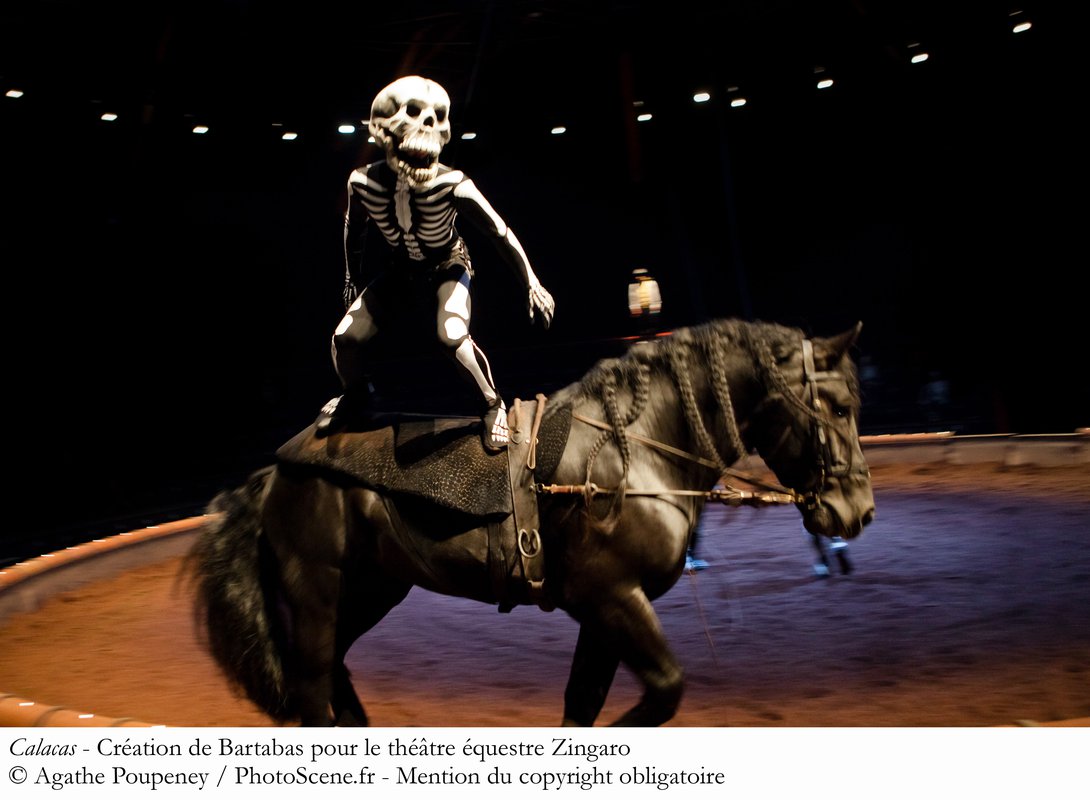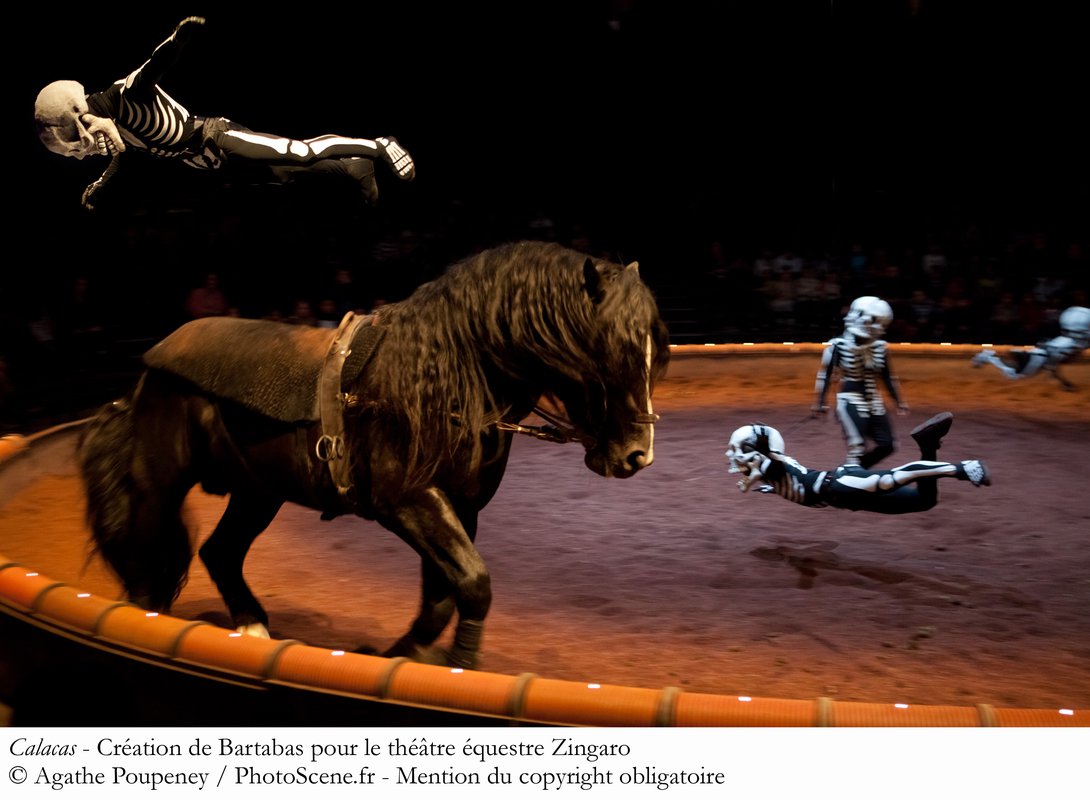Equestrian theater | Theatre
A creation by the Zíngaro Equestrian Theater | Concept, directed and staged by: Bartabas | Assistant stage director: Anne Perron | Setting and costumes: Laurence Bruley | Masks: Cécile Kretschmar | Musical consultant: Jean-Pierre Drouet | Photography: Agathe Poupeney and Hugo Marty | Drawings: Ernest Pignon-Ernest | Coproduced by: La Coursive Scène nationales, La Rochelle, Les Nuits de Fourvière (Lyon), LMP Music Production (Switzerland) | Horse riders: Laurence Dirou, Michaël Gilbert, Noureddine Khalid, Mathias Lyon, Gaëlle Pollantru, Etienne Régnier, Alice Seghier, Messaoud Zeggane | Percussionists: Sébastien Clément alternating with Théo Mérigeau, François Marillier alternating with Richard Dubelski | Chinchinero musicians: Pepa Toledo, Luis Toledo | In the role of El Barón: El Barón | Horses: Antonete, Arruza, Belmonte, Bombita, Cagancho, Calacas, Chamaco, Chicuelo, Conchita Citron, Dominguín, Edwin, El Cordobés, El Gallo, El Soro, El Viti, Espartaco, Joselito, Lobero, Majestic, Manolete, Manor, Manzanares, Nimeno, Paquiri, Phare Ouest, Posada, Tarzán.
Bartabas
Creator
A pioneer of equestrian theater
Born as Clément Marty in Courbevoie, France in 1957, Bartabas is a multifaceted artist: a horseman, theater director, choreographer and theater creator. He’s one of the main driving forces behind equestrian theater, a discipline that combines dance, comedy and horses to create stories. He made his debut at the Avignon Festival in 1977 and founded his own company called the Zíngaro Equestrian Theater in 1985, with its own stage adapted especially for shows starring horses. Among the company’s main works, Cabaret ecuestre (1984), Ópera ecuestre (1991), Chimère (1994), Eclipse (1997), Triptyk (2000), Loungta (2003), Entr’apercu (2004), Batutta (2006), Darshan (2009), Calacas (2011) and Golgota (2013) particularly stand out. The captivating presence of a troupe of horses on stage is what all of them have in common.
“Wild, entertaining, serious”.
“Calacas conveys a buoyant energy in which the macabre is never morbid; it’s completely loyal to the spirit of the Day of the Dead, its humor and the elegance of its skeletons”.
-It’s a captivating production that touches both young and old alike through its impressive staging - a two-tier stage where the horse riders are in a kind of purgatory and the horses in heaven - as well as its message to stop considering death as a taboo but rather view it as part of life.
-The last thing the show wants to do is to ‘appropriate’ this Mexican tradition. Bartabas admits he’s never been to Mexico and that, in fact, the inspiration for this production came to him in 2008 when he was in Hong Kong and had the chance to listen to Mexican music. It takes part of its esthetic and turns it into a universal art, even including aspects of Chilean folklore through José and Pepa (Patricio) Toledo, the chinchinero musicians.
Equestrian theater: North American researcher Kimberly Poppiti defines this genre as “plays written or performed with either one or several horses representing important actions or characters as a necessary part of the plot”. In these pieces, the horses are performers who act out the main scenes. Horses appeared in theater for the first time in the eighteenth century under pioneers such as horse rider Philip Astley. Using them involved circus elements and is still very popular in the United States today.
On Instagram, @theatreequestrezingaro
On Facebook, theatreequestre.zingaro
CON EL APOYO DE
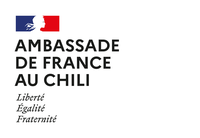
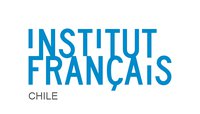
Calacas
By Bartabas – The Zíngaro Equestrian Theater
- France
- 90 minutes
- + 5 years
Mexican music, skeletons and humor come together in a celebration to honor death: a spectacular show starring horses by mythical French choreographer Bartabas.
After spending more than 25 years putting together his Zíngaro Equestrian Theater, French choreographer and artist Bartabas created Calacas in 2011, a celebration inspired by death, the rite of passage to the other side and heaven. Inspired by Day of the Dead drawings by Mexican illustrator and engraver José Guadalupe Posada, a cast of horses takes to the stage, with the dead coming back and interacting with them in a celebration that is beautiful, lively and macabre all at the same time. It’s a manic carnival that’s intensified by the dancing of the chinchinero musicians, Mexican music, the Catrina skeletons that have become an icon of the Mexican Day of the Dead and the sound of street organs. In this, the horses become psychopomps: mythical beings - companions, messengers and guardian angels - in charge of leading the souls of the dead to their final destiny.
Calacas
By Bartabas – The Zíngaro Equestrian Theater
- France
- 90 minutes
- + 5 years
Mexican music, skeletons and humor come together in a celebration to honor death: a spectacular show starring horses by mythical French choreographer Bartabas.
After spending more than 25 years putting together his Zíngaro Equestrian Theater, French choreographer and artist Bartabas created Calacas in 2011, a celebration inspired by death, the rite of passage to the other side and heaven. Inspired by Day of the Dead drawings by Mexican illustrator and engraver José Guadalupe Posada, a cast of horses takes to the stage, with the dead coming back and interacting with them in a celebration that is beautiful, lively and macabre all at the same time. It’s a manic carnival that’s intensified by the dancing of the chinchinero musicians, Mexican music, the Catrina skeletons that have become an icon of the Mexican Day of the Dead and the sound of street organs. In this, the horses become psychopomps: mythical beings - companions, messengers and guardian angels - in charge of leading the souls of the dead to their final destiny.
A creation by the Zíngaro Equestrian Theater | Concept, directed and staged by: Bartabas | Assistant stage director: Anne Perron | Setting and costumes: Laurence Bruley | Masks: Cécile Kretschmar | Musical consultant: Jean-Pierre Drouet | Photography: Agathe Poupeney and Hugo Marty | Drawings: Ernest Pignon-Ernest | Coproduced by: La Coursive Scène nationales, La Rochelle, Les Nuits de Fourvière (Lyon), LMP Music Production (Switzerland) | Horse riders: Laurence Dirou, Michaël Gilbert, Noureddine Khalid, Mathias Lyon, Gaëlle Pollantru, Etienne Régnier, Alice Seghier, Messaoud Zeggane | Percussionists: Sébastien Clément alternating with Théo Mérigeau, François Marillier alternating with Richard Dubelski | Chinchinero musicians: Pepa Toledo, Luis Toledo | In the role of El Barón: El Barón | Horses: Antonete, Arruza, Belmonte, Bombita, Cagancho, Calacas, Chamaco, Chicuelo, Conchita Citron, Dominguín, Edwin, El Cordobés, El Gallo, El Soro, El Viti, Espartaco, Joselito, Lobero, Majestic, Manolete, Manor, Manzanares, Nimeno, Paquiri, Phare Ouest, Posada, Tarzán.
Bartabas
Creator
A pioneer of equestrian theater
Born as Clément Marty in Courbevoie, France in 1957, Bartabas is a multifaceted artist: a horseman, theater director, choreographer and theater creator. He’s one of the main driving forces behind equestrian theater, a discipline that combines dance, comedy and horses to create stories. He made his debut at the Avignon Festival in 1977 and founded his own company called the Zíngaro Equestrian Theater in 1985, with its own stage adapted especially for shows starring horses. Among the company’s main works, Cabaret ecuestre (1984), Ópera ecuestre (1991), Chimère (1994), Eclipse (1997), Triptyk (2000), Loungta (2003), Entr’apercu (2004), Batutta (2006), Darshan (2009), Calacas (2011) and Golgota (2013) particularly stand out. The captivating presence of a troupe of horses on stage is what all of them have in common.
“Wild, entertaining, serious”.
“Calacas conveys a buoyant energy in which the macabre is never morbid; it’s completely loyal to the spirit of the Day of the Dead, its humor and the elegance of its skeletons”.
-It’s a captivating production that touches both young and old alike through its impressive staging - a two-tier stage where the horse riders are in a kind of purgatory and the horses in heaven - as well as its message to stop considering death as a taboo but rather view it as part of life.
-The last thing the show wants to do is to ‘appropriate’ this Mexican tradition. Bartabas admits he’s never been to Mexico and that, in fact, the inspiration for this production came to him in 2008 when he was in Hong Kong and had the chance to listen to Mexican music. It takes part of its esthetic and turns it into a universal art, even including aspects of Chilean folklore through José and Pepa (Patricio) Toledo, the chinchinero musicians.
Equestrian theater: North American researcher Kimberly Poppiti defines this genre as “plays written or performed with either one or several horses representing important actions or characters as a necessary part of the plot”. In these pieces, the horses are performers who act out the main scenes. Horses appeared in theater for the first time in the eighteenth century under pioneers such as horse rider Philip Astley. Using them involved circus elements and is still very popular in the United States today.
On Instagram, @theatreequestrezingaro
On Facebook, theatreequestre.zingaro
CON EL APOYO DE


